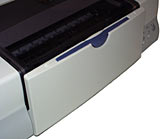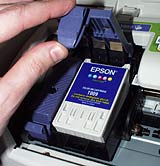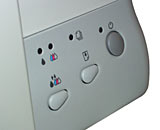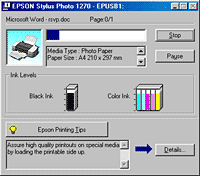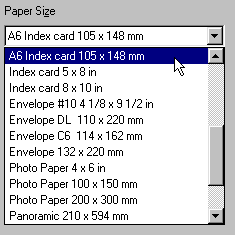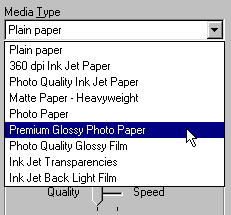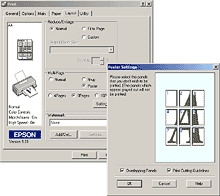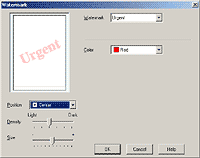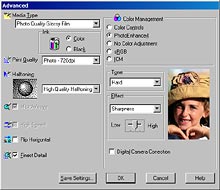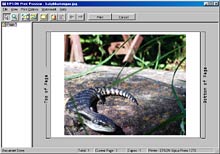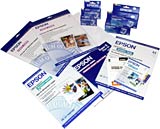
Epson Stylus Photo 1270 photo quality printer
Review date: 26 August 2000. Last modified 03-Dec-2011.
My last printer was purchased in 1988. It's an Epson. Dot matrix. 24 pin. Pretty swish for 1988.
The printer I just bought is also an Epson.
They both put ink on paper.
And that is the end of their similarity.
The Epson Stylus Photo 1270 is the current king of the consumer inkjets. For less than $AU1000 ($AU953.70 including GST from m'verygoodfriends at Aus PC Market, Aussies and Kiwis can click here to buy!), you get a carriage wide enough to handle full A3 size prints, and output quality which is pretty much certain to amaze you if you haven't kept up with the state of the art in inkjet technology.
Essentially, this thing prints photos. And it prints them up to A3 size.
Give it the nice glossy coated paper and its output isn't kinda-sorta-like-a-photo, or nearly-as-good-but-a-bit-fuzzy. It's a photo.
Look at the printouts really really closely and you can see hints of the dot pattern; look at them through a magnifying glass and it's clear enough. At 100X magnification, photo prints from the 1270 on Epson's quite expensive Premium Glossy paper are made out of irregularly shaped coloured scales, a bit like a butterfly wing without the iridescence.
Real photos have a "dot pattern" too, arising from the grain of the film and the print media, but it's far finer than the ink jet dots - it's like comparing sand grains with corn flakes.
Prints from the current Stylus Photo line will pass all but the closest scrutiny. The limiting factor is the resolution of the source image; few digital cameras today can produce images of high enough resolution that it's possible to get a true photo-quality print on larger than roughly six by four inch paper. Go bigger, and the image gets fuzzier, no matter what you print it on.
To get a sharp A3 print you really need a source file at least 3500 by 5000 pixels, and the printer can handle twice those dimensions without losing detail. For this size source, you're talking scanned film, terrifyingly expensive digital photography, or synthetic files knocked together in your paint and/or draw package. Or desktop published documents, of course. A3 lets you print two A4 pages "two-up", next to each other.
With a printer like this and a quality digital camera, you can take a picture, transfer it to the computer, do any cropping and colour adjusting and other twiddling that's needed, and squirt out a super high quality print, all inside ten minutes. None of your dodgy Polaroid instant print rubbish, here; true photo quality, four by six inch or A4 or even A3.
The 1270 comfortably beats the quality of many cheap mini-lab film-camera prints. Automated printing machines seldom do a great job.
And the prints last, too; Wilhelm Research says that 1270 prints on Epson's heavyweight matte paper ought to be light-fast for about 25 years, while prints on the glossy photo paper ought to resist fading for nine to 10 years. Many earlier printers had a hard time keeping prints from fading in one year of occasional sunlight, and three was considered an excellent result.
If you don't need A3 capacity, the Stylus Photo 870 is the A4 sized variant (8.5 inch paper width), and costs about $AU600. There's also the 875DC, which includes a PCMCIA card slot that can accept pretty much any digital camera memory card (with appropriate adaptors for the common, smaller card types), and lets you print images directly without computer-twiddling. The 875DC's a rarer model, and ought to cost about $AU800 locally.
Fancy numbers
Like other super-quality inkjets, the 1270 is a "six colour" unit. It's got one cartridge for black, and one five-reservoir cartridge for colour.
Non-photo-quality inkjets have black, cyan (blue with a lot of green in it, to non-imaging-types), magenta (pinkish-maroon - red with a lot of blue in it) and yellow inks. Six-colour printers like the 1270 add pale cyan and pale magenta, to give them the ability to simulate smaller dots than they can really deliver by using the paler ink.
That said, the 1270 can do some darned small dots. It's got genuine 1440 by 720dpi resolution (assuming you're using paper coated to hold dots that small), and can squirt out droplets as small as four picolitres. That's trillionths of a litre. 250 million minimum-size dots would fill one metric teaspoon.
The print heads have 48 nozzles per ink - 48 for black, and a total of 240 for the five colour inks.
Epson claim up to 69 tonal levels from the 1270/870 print heads, which means about six bit resolution per colour, and may or may not add up to better than 36 bit colour overall, depending on how well naive possible-intensity calculations like this map to the real world.
The input tray can hold up to 100 sheets of normal paper; the output tray holds up to 30. You don't have to extend the paper supports all the way if you don't need them for the stock you're printing on...
...and the output tray can be clicked into this position when you're not using the printer.
Speed
Printing from Photoshop, a 720dpi full-page A4 print will take the 1270 more than three and a half minutes, and maybe a bit more than four. Divide the numbers by about two for 360dpi mode; add another four minutes for 1440-by-720dpi mode.
You're looking at maybe 35 seconds per page for the average text-only word processing document in 360dpi letter quality mode; in economy mode (perfectly legible, but not as pretty), the 1270 rips through plain text at about 15 seconds per page.
Paper sizes
The wide-carriage 1270 can handle paper up to Super B, a.k.a. Super A3, size. That's 13 by 19 inches, or 329 by 483 millimetres. Regular A3 is 297 by 420mm; the oversized variant lets the 1270 print to full A3 size, leaving a white margin that you can cover with a frame or trim off if you want.
For them as don't pay a lot of attention to paper size designations, you can read all about them here. In brief, each A-series paper size is as big as two of the next size down, stuck together on their long edges. A3 therefore has eight times the area of A6, which the 1270 can also handle just fine.
Cartridge life
One of the first questions prospective inkjet buyers ask is "how long does a cartridge last?"
Unfortunately, there's no way to say, for sure.
This is because there's no ISO Standard Picture that everybody has the decency to print over and over again. Different subject matter takes different amounts of ink.
As a vague ballpark figure, 70 six by four inch photo prints per colour cartridge seems a reasonable guess. Maybe 50 A5 size prints. But this is far from set in stone.
Print lots of night-time photos with acres of black sky, and you'll go through black cartridges faster than the average.
Epson themselves quote a 540 page life for the black cartridge, using the ISO/IEC 10561 letter pattern (in case you want to see what this standard actually is, you'll have to buy it from here). There's a low capacity black cartridge, as well, but it's not sold in the USA or, I think, Australia.
The colour cartridge is rated for 330 pages at 15% coverage, but that's probably not at 1440 by 720dpi. Do full-page prints at full resolution and you'll pump out a lot less paper before you need to change the cartridge.
The 870 and 1270 have a new kind of cartridge, that includes a chip that tracks how much ink has been used. Other inkjets just assume that any cartridge that's been inserted must be full; the 1270 and 870 know how much ink is really there.
One advantage of the chipped-cartridge system is that when you're about to print some big job, and you know you don't have much ink left in the cartridge, you can yank the near-empty cartridge out and replace it with a new one. The cartridges have self-sealing ink valves and are perfectly happy to be removed and replaced, and the chip remembers how much ink's been used, so the printer doesn't decide the well-used cartridge is a brand new one when you put it back in again later.
This was and is a standard trick for wringing a few more pages out of an almost-exhausted cartridge on ordinary inkjets, by the way. Since plain inkjets have no idea how much ink is really left, and just start counting from whenever a cartridge is inserted, they can easily be fooled by yanking out an officially "empty" cartridge and then sticking it back in again. Presto, the cartridge is full as far as the printer's concerned, and you can keep printing until you run out of ink in the middle of a page.
The "too-early" empty-cartridge warning isn't just the result of printer firmware that plays it safe to avoid half-printed pages, though. It's there to prevent clogs.
If a cartridge runs completely dry, so that air gets into the ink channels, you can get a nasty blockage of dried ink. Clogs at the ink-delivery end of the system aren't all that big a deal - the printer just blows its nose, so to speak, to get rid of them. Clogs in the cartridge aren't too terrible, either; the worst case scenario is that you just have to change the cartridge. Blockages inside the printer's own ink channels, though, can be difficult or even impossible for the printer to move.
Some inkjet cartridges - the really expensive ones - have the print head built in. Change the cartridge, change the head; presto, clogging problems are cured, by the simple application of large amounts of money.
Cheaper cartridges, like the ones used by the 1270, are really just glorified ink reservoirs. Ink flows down little channels from the cartridge to the print head. The expensive head is part of the printer, and if there's a clog behind it that can't be shifted, you're in trouble.
The solution is to report an empty cartridge when there's still some ink left, to keep the system wet all the way through.
The 1270 and 870, therefore, leave ink in the cartridge by design, and the chip system means you don't have a choice about it. You can't use the last little bit of ink whether you want to or not. Well, maybe you can, but nobody's figured out how to yet.
And nobody's figured out how to refill the new-style cartridges, either.
Penny-pinching inkjetteers are familiar with refill kits. They let you squirt ink back into the cartridges, so you don't need to buy as many alarmingly expensive cartridges. Inkjets that have no way of monitoring how much ink is actually in the cartridge work just as well with a refilled cartridge as they do with a genuine new one. Well, they do if the refill ink works properly in them, anyway.
For many printers, you can also get "compatible" cartridges, which are new carts made by a third party. And there are recycled carts, too.
For lower resolution inkjets, refill kits and non-original carts are often perfectly fine. You may get a few more clogs from lower grade ink. Or you may not. In any case, the saving's worth it, for many users, especially with expensive head-built-into-the-cart printers.
Putting ink back into Epson's chipped cartridges is probably no big deal, but it's pointless unless you can reset the chip as well, so the cartridge no longer tells the printer that it's empty. Nobody's managed to find a way to reset the chip yet, so refilling 870 or 1270 cartridges is a waste of time.
Changing cartridges, at least, is easy. Just open the cover, press the yellow button thus revealed, and the carriage moves to the left. Now you can easily pop out the old carts and click in the new.
In use
The 1270 has both USB and parallel ports; you can use parallel with pretty much any PC, and USB with any late model Windows 95 or Windows 98 machine, or Windows 2000. If you've got a Mac, you need a USB-capable one. In the ancient tradition of printer companies, Epson don't include a parallel or USB cable with the printer.
Inkjet printing is always pretty quiet, but the 1270 has a pleasingly quiet drive motor as well. It makes a selection of odd mechanical noises while performing its new-cartridge ink-charging ritual, but in normal printing it just sings quietly (that's the high frequency piezo-electric ink delivery system, I suppose) and clicks now and then. Even super-sensitive types should have no problems with this printer.
The control panel's about as simple as they come. Power button, load/eject button, head-clean button. You can run test cycles by holding buttons as you turn the printer on, as usual, or you can run them from the printer driver's Utility tab.
The Windows driver (available for 905/98, NT and 2000) is comprehensive and comprehensible. This is the display you get while you're printing - there's a real-time update of the amount of ink remaining. When the ink starts getting low, the driver tells you how many more pages like the last one you're going to be able to print.
There are, of course, tons of paper sizes to choose from when you're setting up a printout. You can define your own paper size, too.
And there are various kinds of media to choose from, too. Markedly absent are any kinds of paper not made by Epson, but the paper-type picker isn't a tremendously touchy thing; select a similar Epson paper and then twiddle the other settings and you can make the driver suit just about anything.
If A3 just ain't big enough, there's always the multi-sheet poster mode, that lets you print on four, nine or 16 pages, to be stuck together at your leisure, with or without overlap and crop marks.
You can also add a watermark to your image - background text, or a BMP graphic, that you can set to be as subtle or as obvious as you like, move around, and so on.
The driver lets you do a lot of image adjusting tweaking, or none at all. The default Automatic setting will do fine for most prints (the printer defaults to "High Speed" bidirectional mode, but turning this option off makes little to no perceptible difference), but if you want to you can pick and tweak canned settings for different kinds of photo, apply various enhancement effects directly, or dive in and twiddle with the contrast, brightness, gamma and so on.
Imaging pros can also create or download Integrated Colour Management (ICM) profiles to suit particular media and the 1270, and use them to perfectly optimise the printer's output to particular stock.
But the difference between a minimally twiddled print and a totally pro-tweaked one is likely to be quite subtle. Joe Schmoe really can get stunning results out of this thing without doing a course in print production.
This is the nifty Print Preview, which gives you an excellent, zoomable view of what's going to be printed. The preview lets you abort the print if it becomes apparent that you've picked substantially incorrect image adjustment settings, or mis-scaled your picture so that it's a postage stamp in the middle of the page, or in some other way created the opportunity to spend a few dollars on nothing worthwhile.
To get the slightly updated current version of the driver - which is, apparently, an excellent idea if you got a 1270 or 870 a while ago, when they came with an earlier version of the driver disc - Epson UK's download site here is easier to navigate than the US one.
You can share the 1270 on a network just like any other printer, but the driver doesn't seem to like not having the printer locally connected to report its ink status. I got the odd communication error when I dawdled over the print preview, though I did manage to print documents OK by cancelling the errors and having another go.
Epson resell a plug-in print server gizmo, the Axis 1440, that connects to a printer parallel port on one side and to the network on the other, and turns a plain printer into an inherently network-enabled one. This isn't an Epson-only idea, though; I review another such gadget here. If you don't want to use a computer as a print server - and possibly have to deal with driver errors - a baby server unit like this could be handy.
The real cost
Ink jet printers are expensive to run. This is not a big secret. They're quiet, and non-photo-quality ones are very cheap to buy, but you gotta pay per page.
An inkjet printer doing ordinary black-only business-document printing can be expected to squirt something like 20 Australian cents worth of its cartridge capacity onto each page. A laser printer putting the same amount of black on the page will cost you about four cents, and dot matrix printers have a per-page cost that approaches zero.
When you get into photo printing, though, modern inkjets really give you the chance to see how much money you can spend per hour.
If you want to do the minimum amount of fiddling around and the maximum amount of quality printing, you should buy brand name paper from the same people that make your printer. And paper with the Epson name on the packaging (the rather sturdy packaging - you get easily as much cardboard and plastic as you do paper), varies in price from a bit steep to awesomely expensive.
250 sheets of nice Epson-branded uncoated plain paper is less than $AU9.50. A hundred sheets of matte coated photo paper's only $AU27.50, and will give noticeably better photo-print results than will ordinary photocopier paper. But if you want the ooh-ah results you get from the various glossy stocks, it's time to smash the piggy bank.
If you've ever wondered what $AU440 worth of Stylus Photo 1270 consumables looks like, here it is.
Two colour cartridges - $AU50 each. The 1270 has a larger capacity, more expensive colour cartridge than the 870; it needs it, if it's going to be able to print A3 sheets.
Two black cartridges - $AU35 a go. These work in both the 870 and the 1270.
And a load of ultra-deluxe paper. A couple of 20 sheet packs of coated, shiny A4 Photo Paper, one 20 sheet pack of shinier A4 Glossy Paper, and one 20 sheet pack of Super B (or Super A3) Premium Glossy Photo Paper, the niftiest coated paper Epson make that still has cellulose in it. This last is a snip at $AU125 or so, list price.
And three packs of Photo Quality Glossy Film, which Epson used to call High Quality Glossy Paper. Two 10 sheet A6 packs (less than $AU9) for photo-size prints, one 15 sheet A4 pack ($AU54!).
Epson changed this last product's name partly because they seem to have a covert policy of making their consumables catalogue as confusing as possible, but mainly because this stuff isn't actually paper at all. It's plastic, with an ink-retention coating. It's not as satisfying to hold as the heavier Premium Glossy paper, but it's much tougher, shrugs off water, and is eminently suitable for demanding professionals or people with more money than sense.
I, of course, am a demanding professional. Shut up.
The prices quoted above are full list, which is paid only by people whose primary contribution to the world is helping to keep the trees healthy by emitting carbon dioxide. There are plenty of places that charge a bit less, and some that charge a lot less, particularly for the larger packs of the less exotic media.
And there are plenty of other paper brands - Hewlett-Packard and Canon make some good papers, and dedicated brands like Pictorico are spoken of with affection by various professionals. Many people report that some off-brand glossy coated papers are excellent, and most of them are well worth the money, for prints on which the fate of planets is unlikely to depend.
Epson themselves make all sorts of specialty media. You can get transparency film (more than $AU2 per A4 sheet), and stickers, and iron-on transfer paper, and back-lit film, and so on. The 1270 can even accept a roll-feeder that'll let you print a document up to 13 inches wide, and up to 44 inches long - 33 by 112 centimetres.
More sanely, there are 100mm wide eight metre rolls as well. The Stylus Photo 870 comes standard with a roll feeder to suit them. You can use the rolls to print edge-to-edge photos - 50 of 'em fit on a roll. There are some special little felt pads visible through holes in the printer's carriage base; they're there to catch the overspray from edge-to-edge printing, and they're only in the right places for 100mm wide stock, so that's all you can edge-to-edge print. If you're printing to, say, standard 210mm wide A4, you can only print on a maximum of 204mm of its width.
You can also use the roll for panoramic pictures. Printing panoramas is pretty much all that Epson's dumbed-down "Photo Reproduction Lab" package is good for; it's a nice looking but feature-light picture organiser and printer, and most people can safely leave its CD in the printer box.
The 100mm rolls come in glossy or matt, and even the glossy one costs less than $AU35 list.
It's not hard to find places that stock consumables for this top-end printer, even here in backward little Australia. Just call Epson and ask where to go in your area.
Print quality
I've said it before, and I'll say it again - photo printing can't get better than this.
Oh, sure, the driver can mess up images that don't fit the colour correction settings you've asked for - brightening up your picture of a black cat until it's painfully grainy, or turning shadows into pools of inky blackness because of a mistaken gamma setting - but, by and large, this thing prints photos, provided you use the expensive coated paper.
On plain paper, even heavyweight cotton rag letter-from-the-Queen plain paper, you can't print at as high a resolution, mainly because the ink spreads out a bit before it can dry. The ink spread also makes it impossible to get the super-sharp edges and huge tonal range that ink-grabbing coated paper offers, and ink that soaks into the paper isn't visible. If three quarters of every teeny dot soaks in so you can't see it, and half of the remainder spreads out into a splodge much bigger than the dot should be, it's hardly surprising that the results aren't that inspiring.
If you've dropped the cash on coated paper, though, the dots stay the size they're meant to be, and not much of the ink escapes into the paper. And you get photos.
The 1270 does well on monochrome prints, as well. You can print them halftoned, using black ink only, or you can print them in colour mode, whereupon the printer will use a little colour ink to fill in the tones, giving a more photo-like effect.
Print durability
Old-style inkjet prints don't like water. Their ink's thoroughly water soluble. They don't like water vapour either, or that matter; they wrinkle and fade in humid environments. And sunlight fades them much faster than ordinary photo prints.
One of Epson's big selling points for the current Stylus Photo line is that the prints are pretty much as good as real photo prints in durability as well as appearance. Epson like to use the word "archival" a lot.
And they're pretty much right. Leave a 1270 print on the Heavy Weight Matte or Premium Glossy paper sitting in the sun all day every day and it will fade, but so will any print. Hang it on a normal wall behind glass and it'll last for ages.
Prints from the 1270 are also quite highly water resistant. You can, literally, hold a coated-paper print under the tap and the ink will only run a little (though the paper may end up corrugated, depending on how you handle it). Prints on the plastic-based Glossy Film won't wrinkle, but aren't significantly more colour-fast than coated-paper prints. Both are streets ahead of the weepy mess you get if an older inkjet's plain paper print gets wet.
Some users, however, have reported that Premium Glossy Photo Paper prints exposed soon after printing to lots of ozone, and possibly also to unusually high humidity, will develop a nasty orange cast. Epson have confirmed this, and provided the Groucho Marx answer - "so don't do that!"
There's a new Stylus Photo, the 2000P, which uses even higher stability inks, and according to research Epson quote here ought to give better than hundred year indoor display times before any noticeable fading occurs.
From the point of view of most users, the ten year stability of the 1270 and 870 ought to do for the time being.
Overall
The Stylus Photo 1270 and 870 certainly aren't the only horses in the alarmingly-good-inkjet race at the moment.
The top-end Canons do a pretty good job, and the popular Hewlett-Packard photo printers aren't rubbish - though comparisons like the one here make pretty clear that the HP DeskJet 970's not in the 1270's league by a long shot. But Epson are where it's at for pro-quality output on the desktop at the moment.
As I said above, as far as image quality goes, you're really not going to see much better than this, ever. Cheaper and faster, sure. But the 1270 and 870 make photos, just as good as real ones, and they make enlargements cheaper than you can get them from a photo lab.
If you're a casual graphics hobbyist who wants tasty output of digital camera pictures, scans and desktop published documents, then you want one of these printers, full stop.
If you're a pro graphics person with a darkroom, you may find yourself doing nothing in it but developing film. There's really nothing much else you can do in a darkroom that you can't do faster and easier with a Stylus Photo 1270 and a quite inexpensive scanner (like the Acer 1240UT, for instance, reviewed here).
You can profitably pull about 3000 dots per inch out of decent slide film or negatives, provided you've got a good enough slide scanner, or take your film to a bureau. So a well-scanned 35mm slide on quality film can be good for better than 4000 by 2650 pixels, and if you're shooting medium format then you can get gargantuan files that can easily do justice to an A3 print.
On the 1270, big film scans like this will come out sharp as a tack and as good as a professional print. Sure, you may have paid more than $AU10 for the funky paper and the amount of ink you just dumped on it, but a lot of output bureaus would cheerfully charge you $AU30 for the same thing. Except they'd probably do it on a big H-P or other inkjet capable of prints up to A0, which is all very well if you need real poster size, but which doesn't do as nice a job as the 1270.
You got your results in ten minutes. You paid less for the print. If you feel like changing something, you can, and have another print in another ten minutes.
I bought this thing. It's great.
Epson Australia's page for the Stylus Photo 1270
Buy a printer!
US readers can find the best price for all Stylus Photo printers on
DealTime!

